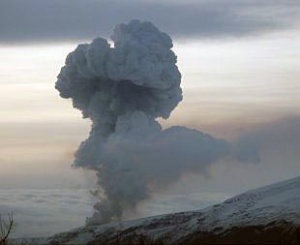Ash cloud moves towards UK and Europe

An ash cloud from Iceland’s largest volcano continues to move towards the UK and mainland Europe, and is expected to reach the eastern coast of Ireland and northern Russia. Flights in Scotland have been cancelled by regional airline Loganair on Tuesday as the Civil Aviation Authority warns that disruption cannot be ruled out.
Airspace over Iceland remained closed throughout Monday, and transatlantic flights re-routed around the country.
Andrew Haines, chief executive of the CAA, said: “Our number one priority is to ensure the safety of people both onboard aircraft and on the ground. I think we are far better prepared and we’ll have far better information and intelligence.”
“We can’t rule out disruption, but the new arrangements that have been put in place since last year’s ash cloud mean the aviation sector is better prepared and will help to reduce any disruption in the event that volcanic ash affects UK airspace.
Grimsvoetn began erupting late on Saturday, sending a plume of smoke and ash 12 miles high. By Sunday, it had spread to the capital Reykjavik, nearly 250m to the west, and all of Iceland’s airspace was closed.
ADVERTISEMENT
Grimsvoetn is the country’s biggest volcano, but vulcanologists said the eruption is unlikely to be as severe as the ash cloud crisis caused last April by Eyjafjallajökull.
Gunnar Gudmundsson, of Iceland’s Meteorological Office, said: “I don’t expect this will have the same effect as Eyjafjoell volcano because the ash is not as fine.”
However, they acknowledged that changing weather patterns could sweep the ash into areas where it would affect other countries.
The Eyjafjallajökull eruption last spring resulted in 34 countries closing their airspace, the largest since the Second World War and millions of passengers were affected.
The International Air Transport Association (IATA) estimated that the global airline industry lost £130million a day during the disruption.
But Einar Kjartansson, a geophysicist at Iceland’s Met Office, warned: “If the eruption lasts for a long time we could be seeing similar effects as seen with Eyjafjallajökull last year.”
He added that “most of the traffic at least to the south of Iceland will probably not be affected” but said: “We don’t know what will happen after that.”
The forecast is for winds to clear the ash from Reykjavik and dissipate the problem over the coming days.
Eurocontrol, the European air safety organisation, said no impact was expected on European airspace outside Iceland or on transatlantic flights for at least 24 hours.
Grimsvoetn has erupted nine times between 1922 and 2004. When it last erupted in November 2004, volcanic ash fell as far away as mainland Europe and caused minor disruptions in flights to and from Iceland.
A spokesman for the Civil Aviation Authority said: “It is early days and we’re keeping an eye on the situation but at the moment the weather patterns are looking pretty favourable.
“It’s the kind of situation that can change very quickly but we’d be very unlucky to be affected again as the winds normally would take this kind of problem away from us.
“The only problem passengers are likely to have is if you’re going to Iceland.”

